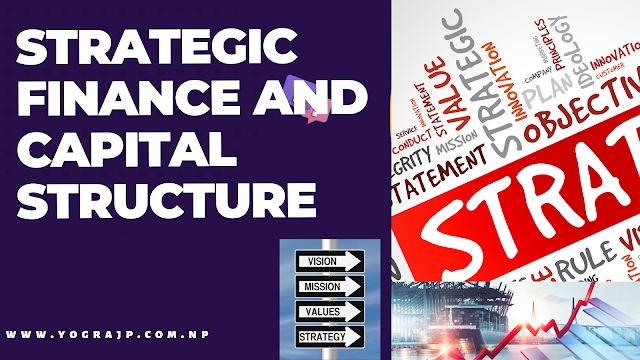Strategic Finance and Capital Structure
For a long time, the capital structure decision was thought to be solely a financial decision. In fact, though, this choice has long-term strategic repercussions. Because they failed to grasp these ramifications, companies have continued to study finance and strategy in isolation. As a result, when the same scenario is studied from two separate perspectives, the firm frequently receives confused and even contradicting messages. This contrast has been apparent to both investors and managers over time. As a result, they have advocated that capital structure decisions be made in an integrated manner, taking into account the perspectives of both the strategic and financial teams.
Capital structure choice has been explored from a strictly mathematical standpoint in the study of corporate finance. As a result, some academics feel that the capital structure is useless to the firm if certain elements such as transaction costs are not taken into account. The reality differs dramatically from these theoretical notions. In this post, we’ll look at the strategic consequences of the firm’s capital structure decision.
Different Stakeholders Have Different Objectives:
Firstly, it is important to realize that any organization is not made up of numbers. Organizations are made up of people and the interactions between the various stakeholders play a key role in the process. For instance, it is a known fact that debt holders and shareholders have different and even conflicting objectives. Shareholders are inclined toward taking on excessive risk whereas debt holders do not have an incentive to take any risks since their returns are fixed. This is the reason that organizations are constantly torn between the politics caused by these two rival groups. Taking on debt means introducing new stakeholders into the mix. If the organization cannot control the different stakeholders and ensure efficient decision-making, taking on debt can cause much more harm than thought earlier.
Increased Governance Costs:
Also, from a strategic point of view, if a company decides to borrow large sums of money, it needs to interact with more stakeholders. On the one hand, it needs to interact with the debt holders and give them accurate information. On the other hand, the firm is also forced to interact with certain parties such as credit rating agencies. These external parties demand information from the firm and it is their responsibility to oblige promptly. The end result is that companies that borrow money tend to have stronger governance structures. This is because they have to share information with the outside world more frequently. This may work to the firm’s advantage as more governance leads to better decision-making. It can also work to the firm’s disadvantage as more governance also means increased costs.
The Diversification Effect:
Capital structure also depends upon the strategy which is being used by the firm. This means that if a firm sells a wide variety of related products, it should refrain from taking on too much debt. This is because of the fact that if their business faces a downturn, all the related businesses will face a downturn at the same time. This means that the company will face a cash crunch and may not be able to service its debt.
On the other hand, if the company is a conglomerate that owns a lot of diverse businesses, then it can afford to take on more debt. This is because the performance of their businesses is not correlated with one another. As a result, even if one business faces a downturn, the other might be able to provide the cash flow required to service the debts.
Types of Assets:
The type of assets that a company plans to buy with the proceeds also has an important bearing on the capital structure. If the firm plans to buy generic assets such as land or vehicles, then it can use debt. This is because if they are unable to pay back the debt, the lender will simply take control of the asset and sell it. The company taking the loan might have to face a loss. However, that loss might be minimal. At the same time, if the company is purchasing assets that are very specific to their business and have no value to other businesses, then equity might be a preferred option. This is because in such cases, the assets cannot be sold to recover the dues and hence the organization ends up in financial duress.
Competitive Capital Structure:
Lastly, it also needs to be understood that many companies use capital structure to compete with their peers. For instance, if the peers of a company are highly leveraged, then it might deliberately avoid leverage. Then, when a recession comes, the company might deliberately drop its prices. Since it has no interest to pay, it will be able to sustain the pricing whereas since its competitors have the interest to pay, they will not be able to compete and will end up losing market share.
The bottom line is that the capital structure decision is considered to be a purely mathematical decision in traditional finance. However, strategic finance tries to look at the bigger picture and hence takes into account the competitive as well as strategic ramifications of the decision.

More Articles are:
-
-
- 1. What is Strategic Budgeting?
- 2. Strategic Capital Budgeting
- 3. Profit Maximization vs. Wealth Maximization
- 4. Strategic Financial Management’s Drawbacks
- 5. Advantages of Strategic Financial Management
- 6. The Strategic Financial Planning Process
- 7. Principles of Strategic Financial Management
- 8. Strategic Financial Management – Meaning and Its Functions
-


